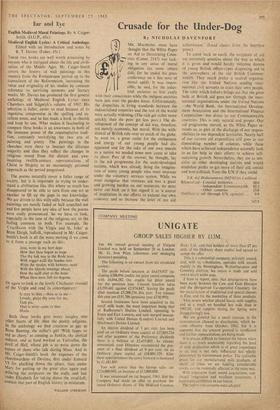Ear and Eye
Medieval English Lyrics: A Critical Anthology. Edited with an introduction and notes by R. T. Davies. (Faber, 45s.)
THESE two books are well worth possessing by anyone who is intrigued about the life and civili- sation of the Middle Ages. Mr. Caiger-Smith covers the history of wall paintings in this country from the Romanesque period up to the iconoclasm of the Reformation, increasing the value and originality of his studies by constant reference to surviving sermons and literary works. Mr. Davies has produced the first general anthology of Medieval English Lyrics since Chambers and Sidgwick's volume of 1907. His selection is fuller, easier to read because of its ingenious compromise in the spelling and ex- cellent notes. and he has made a book to cherish and keep by one. What makes it fascinating to compare these books is an awareness in both of the immense power of the contemplative tradi- tion, constantly revivifying the two arts of painting and poetry The paintings in the churches were there to instruct the illiterate majority and thus they reflect the changes in religious mood from the distant and awe- inspiring twelfth-century representations of Christ in Majesty to an increasingly personal approach as the period progressed.
The poems naturally cover a fuller range of society, but it is important in trying to under- stand a civilisation like this where so much has disappeared to be able to turn from one art to another to fill up the gaps in our knowledge. We are driven to this willy-nilly because the wall paintings are mostly faded or half scratched out and few people have any idea of how the poems were really pronounced. So we have to look. especially in the case of the religious art, to the feeling common to both. For example, the 'Crucifixion with the Virgin and St. John' at Brent Eleigh, Suffolk, reproduced in Mr. Caiger- Smith's book is all the more moving if we come to it from a passage such as this:
Jest:, write in my hert depe How that thou began to wcpe Tho thy bak was to the Rode bent, With rogget mill thy hander rent. Write the strokes with hameres stout With the bloode renningc about; How the naill stint at the bone Whan thou were full wo-begone.
Or again to look at the lovely Chichester roundel of the Virgin and read its contemporary: he crye to thee,—thou se to me- Levedy, preye thy sone for me.
Tam pia.
That is mote come to thee.
Maria.
Both 'these books give many insights into other facets of life than the purely religious. In the anthology we find creatures as gay as Besse Bunting, the miller's girl 'With lippes so red as chery,' as cunning as Jankin, the clerical seducer, and as hard worked as Tutivullus, the devil of Hell, whose job is to write down the names of those who talk during Mass. And in Mr. Caiger-Smith's book the expenses of the churchwardens of Devizes, first under Edward VI for plucking down the altars, then under Mary for putting up the great altar again and defacing the scriptures on the walls, and last under Elizabeth for taking down the rood-loft, contain that part of English history in miniature.
WILLIAM ANDERSON


































 Previous page
Previous page